Browse our Growing Library of Success Stories
By:
Leopold Conservation Award Program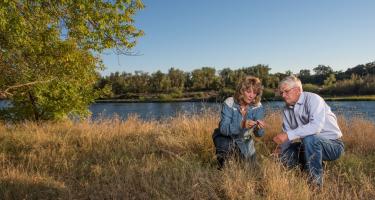 Jim and Mary Rickert have worked in production agriculture all of their lives, developing a deep love for the land and wildlife on the many acres they manage. Hired in 1979 by the original owner of Prather Ranch, the Rickerts have responsibly managed the land and recently became majority owners. Under their care, Prather Ranch has grown from 3,000 acres of pasture, hay and timberland, to over 35,000 acres.
Jim and Mary Rickert have worked in production agriculture all of their lives, developing a deep love for the land and wildlife on the many acres they manage. Hired in 1979 by the original owner of Prather Ranch, the Rickerts have responsibly managed the land and recently became majority owners. Under their care, Prather Ranch has grown from 3,000 acres of pasture, hay and timberland, to over 35,000 acres.
By:
Leopold Conservation Award Program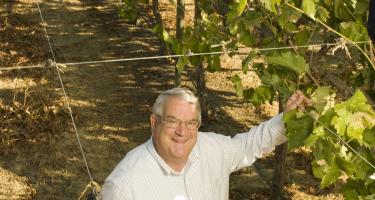 John Diener’s Red Rock Ranch consists of approximately 5,000 acres in Fresno County. He farms an array of high value row crops, using innovative approaches to land, water, and wildlife management.
John Diener’s Red Rock Ranch consists of approximately 5,000 acres in Fresno County. He farms an array of high value row crops, using innovative approaches to land, water, and wildlife management.
By:
Leopold Conservation Award Program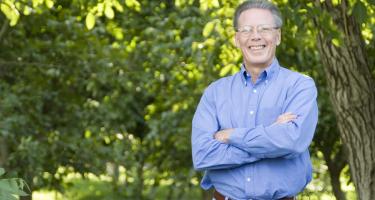 Craig McNamara’s 450-acre Sierra Orchards is a diversified farming operation that includes field, processing, and marketing operations and produces organic walnuts and grape rootstock. Sierra Orchards is proof that an agricultural operation is able to be green without going into the red.
Craig McNamara’s 450-acre Sierra Orchards is a diversified farming operation that includes field, processing, and marketing operations and produces organic walnuts and grape rootstock. Sierra Orchards is proof that an agricultural operation is able to be green without going into the red.
By:
Leopold Conservation Award Program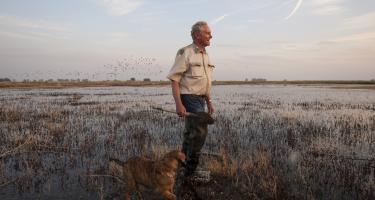 Jeff Thomson’s great-grandfather, C.B. Crawford, began farming near his 160-acre homestead in 1888. After the farm’s water source ran dry, he became a market duck hunter on Jerry Slough, 40 miles west of Bakersfield. With money saved from duck sales, C.B. bought several farming parcels that are still farmed by the Thomson family today.
Jeff Thomson’s great-grandfather, C.B. Crawford, began farming near his 160-acre homestead in 1888. After the farm’s water source ran dry, he became a market duck hunter on Jerry Slough, 40 miles west of Bakersfield. With money saved from duck sales, C.B. bought several farming parcels that are still farmed by the Thomson family today.
By:
Leopold Conservation Award Program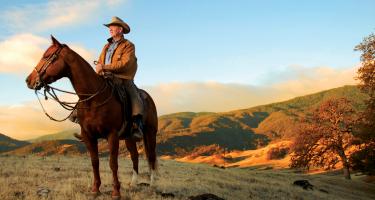 Chet Vogt’s Three Creeks Ranch in Glenn County is a 5,300 acre 500 cow/calf operation. The core of Chet’s holistic approach to ranching is intensive managed grazing, which rotates the cattle among 32 fenced paddocks.
Chet Vogt’s Three Creeks Ranch in Glenn County is a 5,300 acre 500 cow/calf operation. The core of Chet’s holistic approach to ranching is intensive managed grazing, which rotates the cattle among 32 fenced paddocks.
By:
K. Gregg Elliott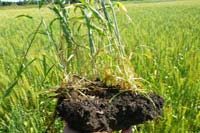 The nonprofit Soil Health Academy (SHA) is just one of many initiatives spawned by regenerative agriculture guru Gabe Brown in collaboration with additional expert partners. SHA holds regenerative agriculture workshops around the country that are open to anyone who’s interested, and they are routinely sold out.
The nonprofit Soil Health Academy (SHA) is just one of many initiatives spawned by regenerative agriculture guru Gabe Brown in collaboration with additional expert partners. SHA holds regenerative agriculture workshops around the country that are open to anyone who’s interested, and they are routinely sold out.
By:
Gregg Elliott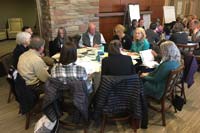 When Heather Dutton, fresh out of undergraduate school at the Warner College of Natural Resources and graduate school in the College of Agriculture at Colorado State University, began her first job working for a non-profit river restoration organization in the San Luis Valley, she was thrilled. She also felt confident that her technical training in restoration ecology had prepared her for the challenges she’d soon be facing.
When Heather Dutton, fresh out of undergraduate school at the Warner College of Natural Resources and graduate school in the College of Agriculture at Colorado State University, began her first job working for a non-profit river restoration organization in the San Luis Valley, she was thrilled. She also felt confident that her technical training in restoration ecology had prepared her for the challenges she’d soon be facing.
Heather was in for a surprise.
By:
Natural Resources Conservation Service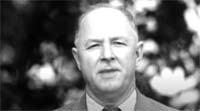 This video is the story of a young scientist, Hugh Hammond Bennett, who recognized 80 years ago that the United States was at risk of losing it’s most important resource – its soil. He made it his mission to change the trajectory of agriculture at a time of great crisis and to provide farmers and ranchers with the information and tools they needed to be sustainable.
This video is the story of a young scientist, Hugh Hammond Bennett, who recognized 80 years ago that the United States was at risk of losing it’s most important resource – its soil. He made it his mission to change the trajectory of agriculture at a time of great crisis and to provide farmers and ranchers with the information and tools they needed to be sustainable.
This 21 minute video is the story of the conservation movement that Hugh Hammond Bennett began and includes interesting insights into the policies and structures that he set up that we continue to rely on today. His work revealed so much of what we’re rediscovering and renaming as “regenerative agriculture.”
By:
Washington Policy Center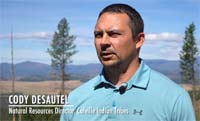 This video from Washington Policy Center with cooperation from the Confederated Tribes of the Colville Reservation, sheds light on how the tribes manage forests to be more healthy using commercial harvests, thinnings, and controlled burns to deal with the pressures of insect infestation, climate change, and decades of fire suppression.
This video from Washington Policy Center with cooperation from the Confederated Tribes of the Colville Reservation, sheds light on how the tribes manage forests to be more healthy using commercial harvests, thinnings, and controlled burns to deal with the pressures of insect infestation, climate change, and decades of fire suppression.
By:
Steve Stuebner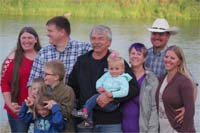 Before knowing much about land trusts, Ashton farmer John Nedrow thought they were some kind of sinister force seeking to take over his farm and force landowners off their property.
Before knowing much about land trusts, Ashton farmer John Nedrow thought they were some kind of sinister force seeking to take over his farm and force landowners off their property.
“Back then, I thought they were the enemy,” Nedrow said in an interview on his alfalfa and malt-barley farm, which straddles the banks of the famed Henrys Fork River, a blue-ribbon trout stream. “I thought they wanted to turn this whole area into national park.”
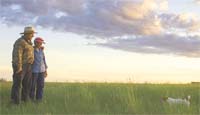 Their introduction to holistic ranch management techniques called into question long-held, traditional ways of thinking. The drastic changes that followed required a leap of faith for the fourth-generation ranchers. They traded harvesting hay for grazing methods that let their cattle harvest the forage themselves. Such changes didn’t happen overnight, and each came with its own risk and learning curve.
Their introduction to holistic ranch management techniques called into question long-held, traditional ways of thinking. The drastic changes that followed required a leap of faith for the fourth-generation ranchers. They traded harvesting hay for grazing methods that let their cattle harvest the forage themselves. Such changes didn’t happen overnight, and each came with its own risk and learning curve.
By:
K. Gregg Elliott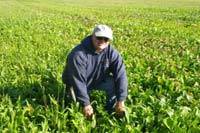 Like almost everyone else in his rural community, Gabe had been farming and ranching using conventional methods since purchasing his Brown’s Ranch from the parents of his wife Shelly in 1991. Possibly because he had not grown up on a farm, Gabe found that he was constantly asking the question, “why do we do things this way?”
Like almost everyone else in his rural community, Gabe had been farming and ranching using conventional methods since purchasing his Brown’s Ranch from the parents of his wife Shelly in 1991. Possibly because he had not grown up on a farm, Gabe found that he was constantly asking the question, “why do we do things this way?”
By:
Northwest Florida Water Management District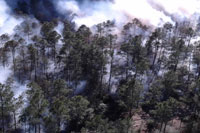 On March 2, 2018, a large prescribed burn occurred at the Yellow River Water Management Area in Santa Rosa County, Florida, which is managed by the Northwest Florida Water Management District. Weather and atmospheric conditions were ideal and resources were available for the Florida Forest Service to approve the burn permit. Aerial ignition via helicopter started the fire systematically across the landscape. Ground firing and monitoring crews, consisting of 15 personnel were stationed at the tract perimeter as ground support during the burn.
On March 2, 2018, a large prescribed burn occurred at the Yellow River Water Management Area in Santa Rosa County, Florida, which is managed by the Northwest Florida Water Management District. Weather and atmospheric conditions were ideal and resources were available for the Florida Forest Service to approve the burn permit. Aerial ignition via helicopter started the fire systematically across the landscape. Ground firing and monitoring crews, consisting of 15 personnel were stationed at the tract perimeter as ground support during the burn.
By:
USDA Forest Service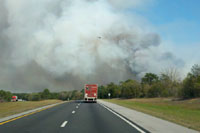 Over four long days in late March 2011, the most severe wildfire outbreak in a decade occurred at Eglin Air Force Base, located near Destin, Florida (Fig. 1). A persistent drought, 20 mph winds and low humidity, combined with 12-15 arson fires on the property, resulted in 6,000 acres burned in a matter of days. Due to Eglin’s aggressive prescribed fire program, the March 2011 wildfire severity and acres burned were significantly reduced. Without this regular fuel reduction, anywhere from 10-12,000 acres could have burned just on the Eglin side, with untold acres burned and property damaged north of Interstate 10.
Over four long days in late March 2011, the most severe wildfire outbreak in a decade occurred at Eglin Air Force Base, located near Destin, Florida (Fig. 1). A persistent drought, 20 mph winds and low humidity, combined with 12-15 arson fires on the property, resulted in 6,000 acres burned in a matter of days. Due to Eglin’s aggressive prescribed fire program, the March 2011 wildfire severity and acres burned were significantly reduced. Without this regular fuel reduction, anywhere from 10-12,000 acres could have burned just on the Eglin side, with untold acres burned and property damaged north of Interstate 10.
By:
US Forest Service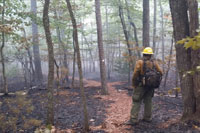 On July 14, 2015, a lightning strike ignited a wildfire on Bald Knob in the Grandfather Ranger District (GRD) of the Pisgah National Forest. Only 30 miles outside of Asheville, North Carolina and on rugged terrain difficult to access, the wildfire may have posed greater threat had it not been adjacent to areas containing recent fuel treatments (prescribed fire) and wildfires. These treatments, as part of the Collaborative Forest Landscape Restoration Program (CFLRP), reduced fire fuel loads in the forest and enabled the Bald Knob fire to safely burn while protecting firefighters, local residents, structures, power line corridors, communication towers, and Forest Service property and surrounding land. Fuel treatments positively influenced the fire’s spread and allowed firefighting efforts to truly focus on protection of private properties. The inaccessible terrain as well as the confine and contain strategy allowed ample time to keep the effected community well informed of current fire behavior, smoke impacts and management plans for the fire.
On July 14, 2015, a lightning strike ignited a wildfire on Bald Knob in the Grandfather Ranger District (GRD) of the Pisgah National Forest. Only 30 miles outside of Asheville, North Carolina and on rugged terrain difficult to access, the wildfire may have posed greater threat had it not been adjacent to areas containing recent fuel treatments (prescribed fire) and wildfires. These treatments, as part of the Collaborative Forest Landscape Restoration Program (CFLRP), reduced fire fuel loads in the forest and enabled the Bald Knob fire to safely burn while protecting firefighters, local residents, structures, power line corridors, communication towers, and Forest Service property and surrounding land. Fuel treatments positively influenced the fire’s spread and allowed firefighting efforts to truly focus on protection of private properties. The inaccessible terrain as well as the confine and contain strategy allowed ample time to keep the effected community well informed of current fire behavior, smoke impacts and management plans for the fire.
By:
Ashley Spratt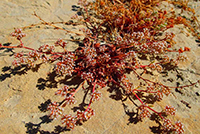 How a Southern California developer helped save the San Fernando Valley spineflower
How a Southern California developer helped save the San Fernando Valley spineflower
By:
Joanna Gilkenson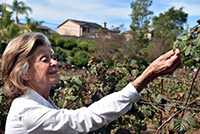 Berry grower embraces conservation and history
Berry grower embraces conservation and history
By:
The Santa Barbara Zoo and the U.S. Fish and Wildlife Service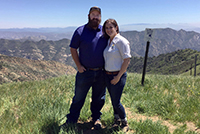 Nadya Seal Faith is a conservation biologist with the Santa Barbara Zoo; Luke Faith is a foreman for Seneca Resources Inc., an oil-production company.
Nadya Seal Faith is a conservation biologist with the Santa Barbara Zoo; Luke Faith is a foreman for Seneca Resources Inc., an oil-production company.
By:
Doug Cordell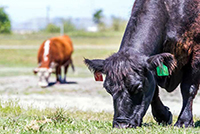 Through a public-private agreement, the ranchers graze their cattle on a 719-acre vernal pool grassland at the Warm Springs unit of the Don Edwards San Francisco Bay National Wildlife Refuge. With this pact, they’re keeping alive a ranching and land conservation heritage spanning four generations. The grazing, in turn, offers a host of benefits for endangered species at the seasonal pond.
Through a public-private agreement, the ranchers graze their cattle on a 719-acre vernal pool grassland at the Warm Springs unit of the Don Edwards San Francisco Bay National Wildlife Refuge. With this pact, they’re keeping alive a ranching and land conservation heritage spanning four generations. The grazing, in turn, offers a host of benefits for endangered species at the seasonal pond.
By:
Ashley McConnell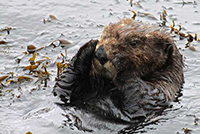 The U.S. Fish and Wildlife Service works with partners to recover the southern sea otter and educate the public about their important role in our coastal ecosystems.
The U.S. Fish and Wildlife Service works with partners to recover the southern sea otter and educate the public about their important role in our coastal ecosystems.